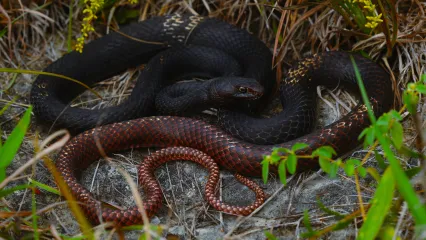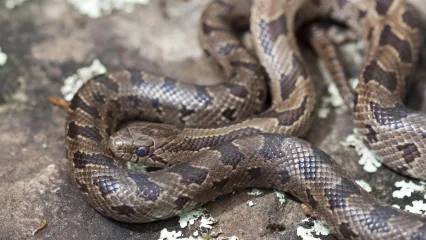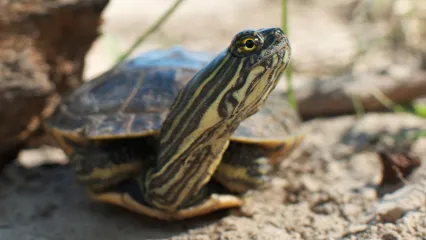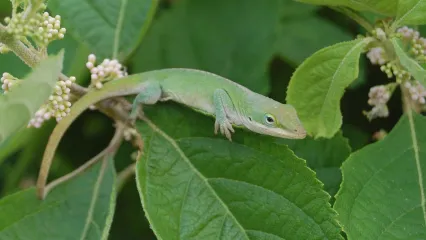
Description
The coachwhip, one of the fastest species of snakes in Oklahoma, has a long and thin tail that makes it bear a resemblance to that of a braided rope. Two subspecies of coachwhips occur in Oklahoma: the eastern coachwhip and western coachwhip, with variable coloration across the state. The smooth scales of eastern coachwhips are dark, almost black on the back closest to the head that fades into a tan to reddish-brown near the end of the tail. Narrow crossbands are noticeable on the neck when coloration on the back is pale tan. Western coachwhips have a fairly uniform color of light tan, light brown and pink across the entire length of their body. The reptile has a beige colored belly with a double row of dark spots running along it and either has long crossbands along the anterior side or short crossbands on the front half of their body. While there is little to no distinguishable characteristics between males and females, juvenile coachwhips have a speckled pattern on their top with narrow or wide crossbands on the neck.
Size
Adult coachwhips vary in size from 36-82 inches and weigh about a pound at 6 feet in length. At hatching, the snakes are about 12-16 inches in length.
Habitat
This species is distributed across the southern half of the United States and found within the entirety of Oklahoma. The eastern and western coachwhips in Oklahoma occur—with respect to their names—east or west of I-35. Coachwhip populations extend westward from North Carolina, eastern Colorado, northward through southwestern Utah, and then southwestward through central and southern New Mexico.
Their ideal habitats tend to vary but are relatively centered around dry and warm areas. Coachwhips may be found in grassland prairies, rocky hillsides, woodlands, and sandy areas.
Life Cycle
After emerging in the spring, coachwhips find mates and females lay a clutch of 4-16 eggs in the beginning summer months. She leaves the eggs hidden in spots such as beneath logs or loose soil for the duration of about one to three months. If the young snakes survive to maturity, they may have a lifespan of 15 years or more. Coachwhips hunt by using their well-developed sight to pursue prey with their head hovering above the ground in search of movement. Their main diets consist of small rodents, other snakes, insects, bird eggs, and lizards.
The coachwhip is a shy species that will most likely retreat into rodent burrows, shrubs or under rocks when frightened. If cornered, it may produce a sound similar to a rattlesnake’s warning by shaking its tail under vegetation. Though non-venomous, the coachwhip will strike quickly at what it believes to be a threat if pressured. Coachwhips are known to be active during the daytime on hot, summer days while most other snakes are inactive. When the weather cools, the coachwhips take to burrows or under any good hiding spots such as under wooden boards.
This profile was created by Kayleen Sugianto.


